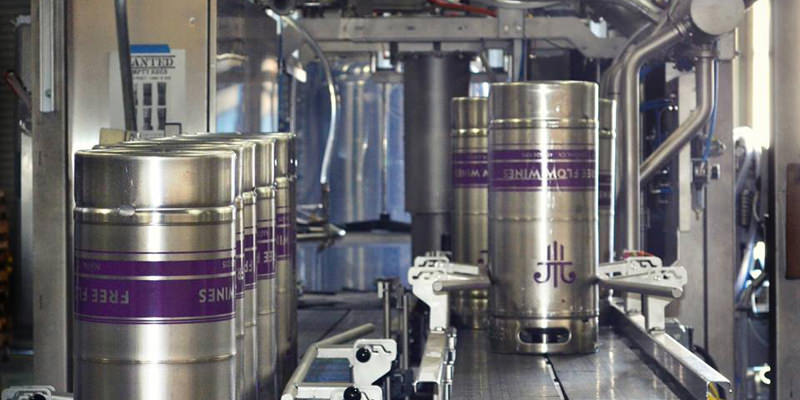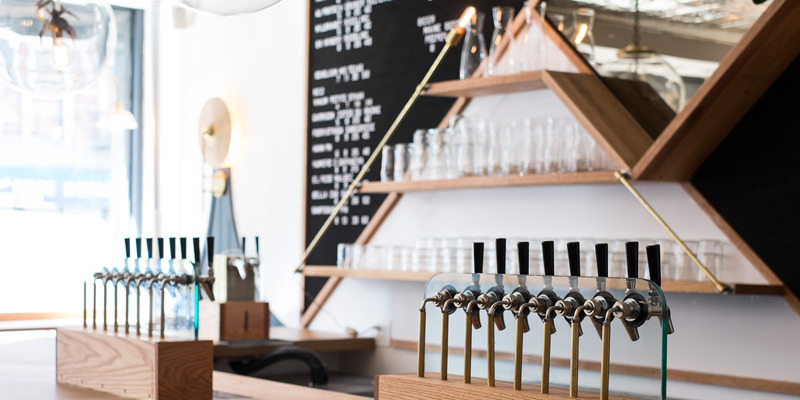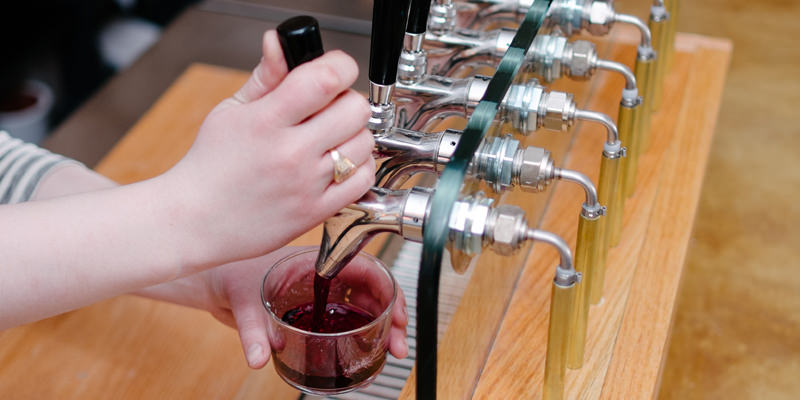Avenue C in Manhattan’s East Village isn’t the first place one might expect to find the first-ever all tap wine bar in New York City. Yet situated directly in the middle of the block between Sixth and Seventh Streets sits Lois, a quaint, inviting wine bar that serves all its wine from kegs. Wine on tap is a phenomenon that has been picking up momentum in recent years. Proponents say it’s more economical, more sustainable, and you’re guaranteed a better quality glass of wine at every pour. But if that’s the case, why hasn’t tap wine exploded? Some say it has started to, but as of right now, Lois is the only all tap wine bar in a sea of competitors popping an endless supply of bottles. So what’s it going to take to get tap wine to truly take off, and as consumers, do we actually want it to?
Dan Donahoe is one of the pioneers of wine on tap. As the CEO of Free Flow Wines, the largest supplier of wine in kegs, Dan is an evangelist whose sole mission is to convince wineries to keg at least some of their juice. His sell is pretty simple and makes a lot of sense: “how much wine that you sell from bottles winds up getting returned, because there’s something wrong with it?” Any winemaker knows there are a ton of things that can happen to a bottle of wine as it travels to its final destination: it can get corked, it can oxidize, it can cook. Dan’s guarantee: “That won’t happen in a keg.”
We’re looking at a savings of about fifty-cents a bottle when you go into keg, this means a bar is saving six dollars a case – those are real savings.
“There’s a reason Jim Clendenen of Au Bon Climat chooses to put some of his most popular wine in kegs,” Dan says, “he knows his premium product is going to taste exactly as it did when he put it in the keg, which, for a wine that is meant to be sold by the glass, is a very important thing. A bottle doesn’t give you that same confidence.” By the glass pours are very important to wineries. While it’s nice to be on a bottle list, it’s a by the glass pour that truly can make a winery money. Dan argues that kegging wine helps ensure more of a winemaker’s wine will be sold by the glass, because a restaurant can always ensure that glass’s integrity.
Maintaining the integrity of the wine might be the most important aspect for some winemakers, but cutting costs is probably more important. Producing wine, especially on the boutique high-end level, can be a very expensive endeavor, and one of the most costly aspects of the process is packaging. While many mass-producers can achieve enormous cost breaks for glass bottles, smaller wineries simply don’t have the buying power, which again provides Dan with a very convincing sell. “We’re looking at a savings of about fifty-cents a bottle when you go into keg,” Dan says. “This means a bar is saving six dollars a case – those are real savings.”
 They are real savings, and they’re savings that allow restaurants to create by the glass programs with great margins. “Most of the restaurants don’t pass those savings on to the customer, they take the margin since the customer is used to paying by the glass prices that are reflected via wine from a bottle, which is great for the restaurant,” says Dan. It’s a strong selling point when it comes to convincing a restaurant to invest in wine-specific draft lines.
They are real savings, and they’re savings that allow restaurants to create by the glass programs with great margins. “Most of the restaurants don’t pass those savings on to the customer, they take the margin since the customer is used to paying by the glass prices that are reflected via wine from a bottle, which is great for the restaurant,” says Dan. It’s a strong selling point when it comes to convincing a restaurant to invest in wine-specific draft lines.
In addition, nothing is wasted. By the glass programs are huge money makers for restaurants, and they’re even more important for music and sports venues. But with bottles there’s always the inherent risk that there will be some waste. At the end of the night it’s not guaranteed that all of the wine will be consumed, meaning you either risk trying to store the open bottles, or you wind up dumping them. With a keg, this waste doesn’t happen. “Caesar’s Palace used to dump hundreds of bottles, now they waste nothing,” says Dan. “Altogether Free Flow has already saved over five million bottles from landfills.”
If tap lines aren’t clean, the temperature isn’t right, the gas mix isn’t perfect or if the pressure is wrong, the wine will end up tasting terrible, similar to what can happen to beer.
This sentiment was echoed by Christopher Russell, who runs food services for the Metropolitan Museum of Art via Restaurant Associates, the company contracted to handle the museum’s food operations. “We’ve looked at wine in kegs extensively, especially when it comes to quick-service options. Moving to wine on tap allows us to move people through the line even faster, which is incredibly important when you’re dealing with thousands of people a day.”
Economically, keg wine clearly makes sense, so what’s holding people back from fully adopting it? As one winemaker from a very prominent winery who did not want to be named put it, there are still many variables one has to contend with when it comes to keg wine. If tap lines aren’t clean, the temperature isn’t right, the gas mix isn’t perfect – you can’t use the same gas that’s used for beer – or if the pressure is wrong, the wine will end up tasting terrible, similar to what can happen to beer. For this winemaker, the bottle avoids those issues, so why risk it?
And as Nora, one of the owners of Lois affirmed, one has to have a lot of passion for tap wine if they want to do tap wine well. “We clean our lines regularly,” Nora said, “and we have a very high commitment to quality, but that’s because we very much respect the winemakers whose wine we sell.” And that respect shows: a visit to Lois allows you to sample a plethora of fantastic wines, and because the wines are on tap, the bar is able to offer several different pour sizes, as well as flights and tastes. It’s an experience you can’t have as easily at other wine bars.
 But Nora also admits she might be in the minority when it comes to people fully understanding how to effectively maintain their tap system. If you adopt wine in kegs for the simple reasoning outlined above, you save money. When that’s your reasoning, corners can get cut. That means wineries who choose to keg their wine really need to be vigilant when it comes to quality. “I hold the hand of every customer I have,” says Robert Karmin, owner of Cooper Hall Winery, an all keg winery in Oregon. “I realize how easily someone new to serving wine on tap can make mistakes, so I make sure people understand how to do it correctly, explaining the need to clean the lines every three months, pushing the wine through the lines to the tap at the proper PSI – pushing wine at the wrong PSI can literally make the wine taste muted – and only having taps that are stainless steel – brass, while pretty, will ruin a wine. I don’t sell to people who do a shitty job with our product.”
But Nora also admits she might be in the minority when it comes to people fully understanding how to effectively maintain their tap system. If you adopt wine in kegs for the simple reasoning outlined above, you save money. When that’s your reasoning, corners can get cut. That means wineries who choose to keg their wine really need to be vigilant when it comes to quality. “I hold the hand of every customer I have,” says Robert Karmin, owner of Cooper Hall Winery, an all keg winery in Oregon. “I realize how easily someone new to serving wine on tap can make mistakes, so I make sure people understand how to do it correctly, explaining the need to clean the lines every three months, pushing the wine through the lines to the tap at the proper PSI – pushing wine at the wrong PSI can literally make the wine taste muted – and only having taps that are stainless steel – brass, while pretty, will ruin a wine. I don’t sell to people who do a shitty job with our product.”
But Robert admits that for the future of wine on tap to be bright it means kegs are going to need to start showing up in sporting and concert venues as well as restaurants across the country and that means more risk. “We’re all just going to need to work much harder on educating the end seller,” says Robert.
If you’re drinking Oregon Pinot Noir by the glass at a restaurant right now, you’re drinking a 2013, the most recent vintage out of a bottle. Why would you not serve that wine from a keg and preserve its integrity?
These venues are essential, as is the need for more mass market brands to jump in. If wine on tap is seen in more places, consumers and sellers will grow used to it. Right now, however, wine on tap faces a scenario similar to the screw cap. While the screw cap very clearly solves the problem of cork taint, it hasn’t been as widely adopted as many had hoped – apart from Australia and New Zealand – and a main reason for that is market preference. Most Americans still want to encounter a bottle closed with a cork when they purchase wine. There is a romanticism and a tradition associated with wine that they’ve come to expect. The same is true for wine on tap: consumers are used to seeing wine poured for them from a bottle, not pulled like a beer from a tap. But with more widespread adoption, that will change.
The key selling point for consumers is that if the bar holds up their end of the bargain, maintaining their tap lines and pushing the wine through at the right PSI using either Argon or what is known as the “Guinness blend,” consumers will always be ensured that the wine will taste as it is supposed to. “If you’re drinking Oregon Pinot Noir by the glass at a restaurant right now, you’re drinking a young wine, a 2013, the most recent vintage, out of a bottle. Why would you not serve that wine from a keg and preserve its integrity?” says Robert. Dan of Free Flow wine concurs, “Most of the wine out there is meant to be consumed immediately, and that’s the wine we keg. Why would I bottle that wine and risk the consumer not experiencing the juice exactly as the winemaker intended?” It’s a very valid point; now more large companies and venues just need to adopt it. That’s the key if keg wine is to ever take off, and it should.

